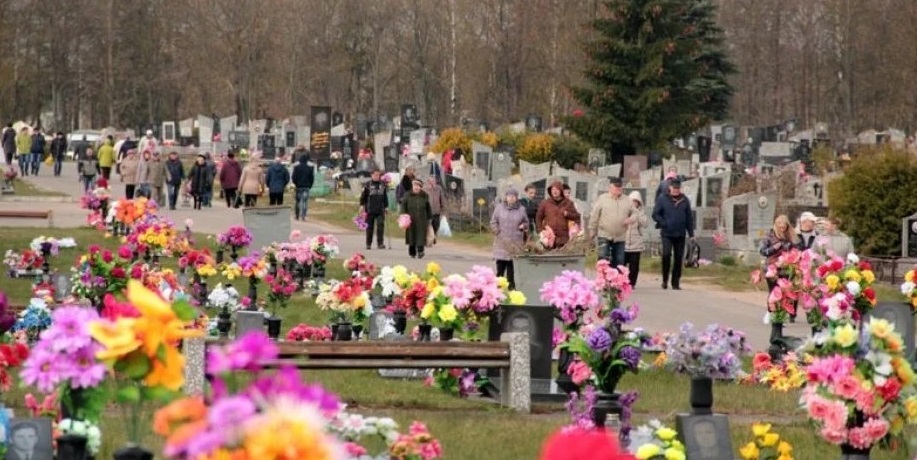Figure 1:
Picture of a “green” burial site. Derived from: https://www.cbc.ca/life/culture/green-burials-everything-you-need-to-know-about-the-growing-trend-1.5340000 (accessed on 5 December 2024)
Introduction
Funerals in Ukraine hold a profound religious and cultural significance. The majority of the population (71,8%), primarily affiliated with the Eastern Orthodox and Greek-Catholic Churches (Razumkov Center, 2023), observe burial rituals steeped in longstanding traditions that carry sacred, sometimes even mystical, meanings. Given the strong emphasis on religious observance and commemoration, the environmental impact of cemeteries is often overlooked or not considered at all.
In the Western world the recent growing trend for "green burials" was observed. This implies a new way of burial, shortly described as the practice of placing the corpse: "in a biodegradable coffin and interred"(Scalenghe &Ottorino-Luca, 2020). In place of artifacts, vegetation—often a tree—is planted near the grave and this cemetery can be located, for instance, in the forest or other natural area (Scalenghe &Ottorino-Luca, 2020). According to the NFDA[1] survey, 68% of the US population "would be interested in exploring "green" funeral options because of their potential environmental benefits", which is 12,3% higher than in 2021(NFDA, 2024). In the Netherlands the amount of people who consider a green burial is increasing by 20% with every passing year (Sanou, 2023).
Considering the religious and cultural significance of burial for most Ukrainians, could the trend of 'green burial' be introduced in Ukraine and other countries affiliated with the Eastern Orthodox Church?
Ecological Impact of Cemeteries and Cremation
One of the main environmental concerns with traditional cemeteries is their use of valuable, high-quality soil—a crucial natural resource that faces sustainability challenges amid rapid population growth. Additionally, research shows that cemeteries can potentially pollute soil and water, with contamination levels especially high and more hazardous in urban areas (Franco et al., 2022). In Ukrainian cemeteries, ecological damage is further increased by the widespread practice of placing artificial flowers at graves and decorating burial sites with large granite monuments or crosses.
The preference for cremation over burial has been growing since the late 20th century, partly due to its minimal land use. However, cremation emits various pollutants into the atmosphere, which can eventually contaminate soil and groundwater, making it less than fully "eco-friendly" (Franco et al., 2022).
"Green" burials present a more environmentally conscious alternative, aimed at reducing cemeteries' negative impact on groundwater, local vegetation, and fauna within burial areas. The primary goals include using materials that biodegrade quickly and minimizing an individual’s ecological footprint (Scalenghe & Pantani, 2019). However, despite their ecological benefits, some researchers note that green burials may face societal acceptance challenges due to cultural and religious beliefs (Zeng et al., 2016).
Ukrainian Funerals in the Orthodox Tradition
Funeral ceremonies and burial rituals hold a significant place in Ukrainian religious culture, particularly within the Eastern Orthodox tradition. Due to theological beliefs, including respect for the body of the deceased, cremation is forbidden in Orthodox Christianity (Earl, 2024), making it an uncommon burial practice in Ukraine.
Commemorative customs express beliefs in an afterlife and a profound, enduring connection between the deceased and the living (Havryl'iuk, 2003). Consequently, not only are funerals and burials themselves meaningful, but special memorial services are held in churches and at gravesites on specific days following death (e.g., 3, 6, 9 days, and 12 months after) and during collective commemorative events, such as Trinity Sunday or St. Demetrius Saturday (Mantala-Bozos, 2003). Visits to cemeteries in Ukraine serve not only as personal moments for reflection but also as family and community gatherings, particularly in rural areas. It’s common for extended families and local communities to gather at gravesites, sometimes sharing meals as a way to maintain a connection with their departed loved ones.

Figure 2: Picture of the cemetery in Ukraine. Derived from https://enovosty.com/uk/news-ukr/news_society-ukr/full/1105-pominalni-dni-pid-chas-mobilizacii-ukrainci-boyatsya-jti-na-kladovishha-cherez-zagrozu-obstriliv-ta-tck
This tradition of communal remembrance highlights the social role that "classical" cemeteries play in Ukrainian culture. Some researchers suggest that this communal approach to remembering the dead positively impacts coping with loss (Mantala-Bozos, 2003). However, as often happens, practices beneficial to people may be harmful to nature. Without a strong ecological consciousness, gravesites are often placed close to water sources or fertile soil and are frequently adorned with artificial flowers and other non-biodegradable materials.
Ukrainian Orthodox priest and theologian Yuriy Kovalenko (2021) advocates for a shift towards eco-friendly funeral practices in his writings. He proposes not only reducing the use of plastic but rethinking funeral and commemorative practices according to "the essence of the Christian vision of death"[2]. He connects this view to the importance of promoting ecological awareness within local churches, referencing the Orthodox Church’s Social Ethos Document (2020), which encourages sustainable practices in line with Christian beliefs.
Conclusion
Is there a future for "green" burials in Ukraine, given its religious context and deep-rooted commemoration traditions? I believe that this burial approach holds promising potential for several reasons. First, it aligns with the teachings of the Eastern Orthodox Church, as it involves burying the body in the earth without alterations, unlike cremation, which Orthodoxy officially prohibits. Second, green burials support a more ecologically conscious lifestyle, answering the call for environmental responsibility in the Orthodox Church’s recently published social doctrine.
However, for green burials to gain broader acceptance, the social aspects of commemoration during and after the funeral process must be thoughtfully adapted to the Ukrainian context. Success will largely depend on the environmental awareness and flexibility of citizens and clergy, as well as their ability to prioritize "meaning" over "form"—especially in light of the ongoing war and the increasing need for green but compassionate burial solutions.
Bibliography
- Earl, A. (2024). Inhumation as Theophanic encounter: the Eastern Orthodox rejection of cremation. Christian Bioethics Non-Ecumenical Studies in Medical Morality. https://doi.org/10.1093/cb/cbae013
- Franco, D. S., Georgin, J., Campo, L. a. V., Mayoral, M. A., Goenaga, J. O., Fruto, C. M., Neckel, A., Oliveira, M. L., & Ramos, C. G. (2022). The environmental pollution caused by cemeteries and cremations: A review. Chemosphere, 307, 136025. https://doi.org/10.1016/j.chemosphere.2022.136025
- Havryl'iuk, N. (2003). The Structure and Function of Funeral Rituals and Customs in Ukraine. FOLKLORICA-Journal of the Slavic, East European, and Eurasian Folklore Association, 8(2).
- Kovalenko, Y. (2021).New ecological culture and ecological theology in Orthodoxy. Ukrainian Religious Studies, 94, 83–97. https://doi.org/10.32420/2021.94.2231
- Mantala-Bozos, K. I. (2003). The role of religion and culture on bereavement: The example of the Orthodox Christian tradition. Journal of Critical Psychology Counselling and Psychotherapy, 3(2), 96-110.
- NFDA.Statistics. (2024). https://nfda.org/news/statistics
- Razumkov Centre. (2023, December 28). Religiosity, Trust in the Church, Confessional Affiliation and Inter-church Relations in Ukrainian society (November, 2023) [Survey]. Retrieved from: https://razumkov.org.ua/en/research-areas/surveys/religiosity-trust-in-the-church-confessional-affiliation-and-inter-church-relations-in-ukrainian-society-november-2023.
- Sanou, H. (2023, September 18). More people are opting for an eco-friendly burial in nature - DutchNews.nl. DutchNews.nl. https://www.dutchnews.nl/2023/09/more-people-are-opting-for-an-eco-friendly-burial-in-nature/
- Scalenghe, R., & Pantani, O. (2019). Connecting existing cemeteries saving good soils (for livings). Sustainability, 12(1), 93. https://doi.org/10.3390/su12010093
- Scalenghe, Riccardo, and Ottorino-Luca Pantani. 2020. "Connecting Existing Cemeteries Saving Good Soils (for Livings)" Sustainability 12, no. 1: 93. https://doi.org/10.3390/su12010093
- Social ethos Document - Greek Orthodox Archdiocese of America. (2020). Greek Orthodox Archdiocese of America. https://www.goarch.org/uk/social-ethos?p_p_id=com_liferay_journal_content_web_portlet_JournalContentPortlet_INSTANCE_km0Xa4sy69OV&p_p_lifecycle=0&p_p_state=normal&p_p_mode=view&_com_liferay_journal_content_web_portlet_JournalContentPortlet_INSTANCE_km0Xa4sy69OV_languageId=en_US
- Zeng, C., Sweet, W., & Cheng, Q. (2016). Ecological citizenship and green burial in China. Journal of Agricultural and Environmental Ethics, 29(6), 985–1001. https://doi.org/10.1007/s10806-016-9643-6
[1] NFDA - National Funeral Directors Association, URL:https://nfda.org/news/statistics
[2] Translation from Ukrainian done by Yuliia Kozak


Greening Ukrainian Cemeteries? Tradition and Trumpery at Eastern Orthodox Burial Sites